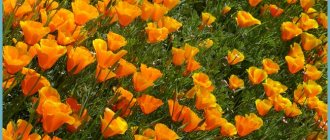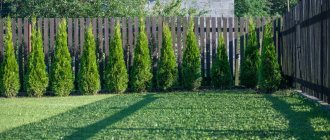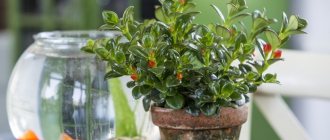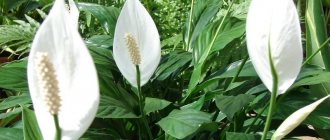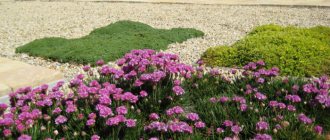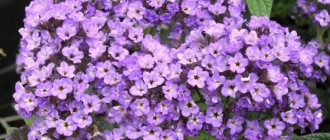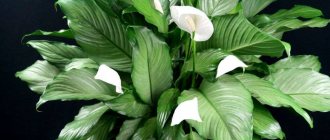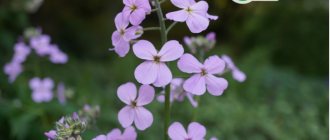Author: Elena N. https://floristics.info/ru/index.php?option=com_contact&view=contact&id=19 Category: Garden plants Published: February 10, 2019Last edits: November 03, 2020
- When to plant
- Growing conditions
- How and when to collect seeds
- Eschscholzia lobbi
The eschscholzia flower is a perennial golden-orange poppy, which is popularly called “wormwood” due to the similarity of the bluish-gray leaves of the plant with the dissected leaves of wormwood. And because of its overseas origin, one of the types of Eschscholzia is called California poppy.
Eschscholzia is becoming increasingly popular in our gardens. From this article you will learn interesting facts about this plant, and also get information about:
- what types and varieties of Eschscholzia are most popular;
- how to grow plant seedlings and transplant them into a flower garden;
- how to care for poppy plants during the season;
- how to collect seeds from Eschscholzia flowers and prepare it for wintering.
Planting and caring for Eschscholzia
- Planting: sowing seeds in the ground in October or April, but after stratification of the seed.
- Flowering: from June to October.
- Lighting: bright sunlight.
- Soil: dry, sandy, not too fertile, but well-drained soils of slightly acidic or neutral reaction.
- Watering: only during dry seasons.
- Fertilizing: before flowering, complete mineral fertilizer. Fresh organic matter cannot be used.
- Reproduction: seed.
- Pests: bean aphids, spider mites.
- Diseases: rot, powdery mildew.
- Properties: a medicinal plant, the use of which is not accompanied by side effects.
Read more about growing Eschscholzia below.
flowers (lat. Eschscholzia) , or California poppy , are a genus of the Poppy family, which includes about a dozen species native to Western North America. An old legend tells that when Spanish gold miners sailed to the shores of America in the 16th century in search of gold mines, they saw a golden glow 35 miles from the coast and, deciding that this was what they were looking for, rushed to the coast of California. How disappointed they were when it turned out that these were the golden fields of Eschszolzia. Since then, the Spaniards jokingly call this flower Copa de Ora - golden cup.
The plant received the name “Eschscholzia” in honor of the Russian naturalist, zoologist, doctor and botanist Johann Friedrich von Eschscholtz, who brought the flower from California to Russia. This plant is as beautiful and romantic as it is unpretentious, which is why it is gaining more and more popularity among flower growers, especially since eschscholzia blooms very profusely in a flowerbed from the beginning of summer until almost winter, and although one flower only lives for 3-4 days , it is immediately replaced by several more flowers and buds.
- Alstroemeria: growing in open ground
Pest and disease control
Eschscholzia is very fond of aphids, which often attack tender foliage in the summer. If dry days last for a long time, this contributes to the appearance of spider mites. In both cases, you need to treat the plants with insecticides as quickly as possible.
As for diseases, most often these are fungi and rot. And they develop due to improper watering. Eschscholzia is accustomed to life in dry regions, so it easily tolerates drought, but very poorly with constant floods. If suspicious symptoms appear, reduce watering as much as possible and use fungicides.
Photo: 2sotki.ru
Verbena (85 photos): types, proper care
Botanical description
Eschscholzia is a herbaceous bushy perennial with a tap root, reaching an average of forty centimeters in height and grown in cultivation as an annual. The shoots of the plant are numerous and thin, bluish-green lacy leaves on long petioles are deeply dissected, cup-shaped single flowers up to 8 cm in diameter, simple or double, very similar to poppies, painted in white, yellow, orange, red or shades thereof . The peculiarity of Eschscholzia flowers is that they close in cold, windy, cloudy or rainy weather, as well as at night. The Eschscholzia fruit is a capsule measuring from 3 to 9 cm.
Growing Eschscholzia from seeds
How to sow seeds
Very often, sowing of Eschscholzia is carried out directly in open ground. When is the best time to sow Eschscholzia? If you sow it before winter, in October, then over the winter it will go through natural stratification, and in the spring you will see strong seedlings that will only need to be thinned out. And the autumn Eschscholzia will bloom faster than the one sown in the spring. If you have a reason to postpone sowing until spring, then put the seeds in the bottom drawer of the refrigerator until April - this way you will both preserve them and stratify them.
Before sowing Eschscholzia, identify a sunny area with dry sandy soil in the garden for it, then make shallow grooves in the soil into which sow small Eschscholzia seeds mixed with sand, plant them shallowly and mulch the area with peat to prevent hardening of the soil , which can prevent seedlings from germinating. Autumn planting is mulched with a thick layer of dry leaves.
Growing seedlings
Growing eschscholzia most often involves sowing seeds directly into the ground. But an interesting fact is that experienced gardeners prefer growing Eschscholzia seedlings, so we invite you to find out how this is done. As we have already written, this crop has a long rod-shaped root system, which is very easy to damage during transplantation, so it is best to sow the seeds in peat tablets.
Planting eschscholzia in tablets and caring for the crops is carried out in the following order: place the tablets in a plastic container and pour water into it, when the tablets absorb water, drain the remaining water, place one seed in each tablet using a wet toothpick, sprinkle the seeds on top with a small amount soil for seedlings, sprinkle the crops with water from a spray bottle and cover the container with glass or film.
The first sprouts will appear in about two weeks, then the glass is removed, the container with the tablets is transferred to a bright place and kept at a temperature no higher than 20 ºC. At this stage, caring for Eschscholzia consists of moistening the soil as needed and applying liquid mineral fertilizer for seedlings two weeks after emergence. Three weeks before planting in open ground, you need to begin hardening off the seedlings by taking them into a cool room for several hours during the day. Hardened seedlings after planting in the ground can withstand temperatures down to -5 ºC.
- How to plant and care for hosta
Growing seedlings at home
The use of seedlings is common in areas with cold climates. The difficulty is that the perennial Eschscholzia has a powerful root core, which can easily be damaged during transplantation. In connection with this circumstance, it is recommended to grow seedlings using peat tablets.
First, cold stratification of the seeds must be carried out within two weeks. At the beginning of March they are planted in peat tablets. They are placed in a container, which must be placed in a place with good lighting and a temperature of 20-22 degrees.
See also
Description of heather aster varieties, methods of propagation and cultivationRead
At the end of April, seedlings are hardened. The containers are taken outside for a short time in order to accustom the perennial Eschscholzia to the desired temperature. At the beginning of May, seedlings can be planted in open ground.
Planting eschsolzia
When to plant
So: Eschscholzia is planted in dry, sandy, well-drained soil with a neutral or slightly acidic reaction. If the acidity of the soil is too high, dig the area to the depth of a spade bayonet, adding 200 g of dolomite flour or two glasses of ash for each square meter. The timing of planting seedlings, depending on the climate in your area, is from April to the second half of May, when the threat of return frosts has passed.
How to plant
Before planting eschscholzia, dig small holes in the area at a distance of 30 cm from each other, since the bushes of the plant are quite spreading. The seedlings are placed in the holes along with peat tablets, sprinkled with soil, compacted, then the area is watered. Eschscholzia blooms from seeds 30-40 days after sowing.
Using seedlings
The seedling method of growing plants ensures their early flowering. It is recommended to sow the seeds in peat pots, since the long root system of the flower is easily damaged during transplantation. Sowing is done in the following way:
- Peat tablets are placed in a container filled with water. When they are well wet, the water is poured out of the container, and the seeds are placed into the tablets using a needle or toothpick.
- The top of the crops is sprinkled with soil mixture for seedlings and sprayed with water from a spray bottle.
- The top of the container is covered with plastic film or glass to create a greenhouse. The peat tablets will not dry out in it.
- When caring for crops, it is necessary to monitor the moisture content of the tablets and remove the cover daily to ventilate them.
- In about two weeks, seedlings will appear. The film will need to be removed and the container moved to a well-lit place where there is no direct sunlight.
Eschscholzia care
Growing conditions
Growing eschscholzia flowers after planting in the ground consists of regular loosening of the soil and timely fertilizing. Eschscholzia needs to be watered only during very dry periods, but if the summer is normal, the plant will have enough moisture provided by the rains. To stimulate long-term and abundant flowering of eschscholzia, before it begins, a complete mineral fertilizer containing potassium, phosphorus, nitrogen and microelements or an infusion of ash in a ratio of 1:10 is added to the soil.
Never use fresh organic matter as fertilizer for eschsolzia - the plant may die from this.
If you are against self-seeding, which is how Eschscholzia intensively reproduces in the garden, then after the flowers wither, remove them along with the seed pods. After the plant has finished flowering, remove the old shoots - Californian eschscholzia will quickly grow new ones, which in 2-3 weeks will bloom more than ever.
Pests and diseases
As you can see, planting and caring for Eschscholzia flowers will not exhaust you, but both planting and caring for Eschscholzia flowers must be carried out in strict accordance with the rules of agricultural technology, otherwise you may encounter difficulties that you did not suspect. For example, at the beginning of summer, bean aphids can adhere to Eschscholzia, which is destroyed by spraying with the drug Komandor.
In hot summers without rain, the plant is attacked by spider mites, against which you will have to use a solution of the Actellik insecticide.
- How to pick petunia from a common container into separate cups
Excessive watering can lead to rotting of the roots and other parts of the eschscholzia; in this case, watering is immediately reduced and rotting areas are removed from the plants. If the damage is too strong, you will have to remove the diseased bushes entirely. In case of powdery mildew disease, the plant is treated with sulfur.
Properties of Eschsolzia
American Indians used the ground parts of Eschscholzia as a remedy for toothache, and Indian squaws considered pollen from flowers as a valuable cosmetic product. Pediculosis was treated with a decoction of flowers. Today in France, eschscholzia is grown as a raw material for the pharmaceutical industry, and in the United States of America, preparations from California poppy are used in pediatrics as an analgesic and sedative. The main advantage of drugs from Eschscholzia is the absence of side effects inherent in many benzodiazepine drugs.
Mister summer resident recommends: medicinal properties of eschsolzia
In fact, every plant in nature has a special purpose. The same is true with this flower. The ancient Indians long ago studied the issue of the medicinal properties of eschscholzia. With its help, they relieved toothache and fought lice. Even pollen was used; it was used to improve skin elasticity and restore its former attractiveness. Modern medicine uses the extract of this plant as one part of multicomponent medications. It is included in sedatives and pain relievers. In addition, medicines based on eschsolzia are 100% safe, which allows them to be used by all people, regardless of age or individual problems with the body.
However, it is worth keeping in mind that nothing is perfect, and eschscholzia-based drugs also have side effects that can only develop if the dosage is exceeded. These include the development of allergies. It does not matter in what form the medicine was used. There may be a decrease in effectiveness, which often leads to an increase in dosage. To avoid unpleasant consequences, you must strictly follow the doctor's instructions.
Eschscholzia after flowering
How and when to collect seeds
If you want to collect seeds for autumn or spring sowing, then don’t worry: the plant gives excellent self-seeding in the fall, and all you have to do in the spring is thin out the seedlings and wait for flowering. The seeds are needed exclusively to start breeding Eschsolzia or to share Eschsolzia with someone. If you need Eschscholzia seeds, put gauze bags on several wilted flowers and, as soon as the seeds are ripe, and this happens about a month after the end of flowering, cut the seed boxes wrapped in gauze from the bush, shake the seeds out onto a newspaper at home, dry them, Place in a paper bag and place in the bottom drawer of the refrigerator until spring. Properly collected Eschscholzia seeds remain viable for up to three years.
Eschsolzia in winter
Even perennial species of Eschscholzia are grown in our conditions as annual or biennial ones, so in the fall, before frost, dig up the area where Eschscholzia grew, removing plant remains. In the spring, even if you don’t really want it, you will again see strong, dense shoots on the site. Thin them out, add fertilizer to the soil, and in a month you will again be able to admire the delicate, tremulous beauty of the Eschscholzia.
Features of sowing at different times
When sown in autumn, plants begin to bloom earlier than those planted in spring.
Autumn
Perennial Eschscholzia reproduces well by self-sowing. During the winter, the least quality seed material will die. In the spring, the most viable seeds will germinate.
Spring
The collected seeds are mixed with sand and placed in paper bags. Store in the refrigerator until spring. Sow as soon as the ground warms up.
Before winter
Seeds can be planted in open ground just before the onset of winter cold. At the first sign of warmth they will sprout and may begin blooming in May.
Types and varieties
In our climate, Californian eschsolzia, soddy eschsolzia and, occasionally, lobba eschsolzia are grown in cultivation.
Eschscholzia lobbi
A low species up to 15 cm tall with light yellow flowers up to 2 cm in diameter.
Eschscholzia caespitosa
It also grows only up to 15 cm in height. Three times dissected thin leaves of bluish-green color, covered with a waxy coating, are collected in a rosette, above which rises a lush cap of bright yellow cup-shaped flowers up to 3 cm in diameter. This species blooms from June and almost until winter.
California Eschscholzia (Eschscholzia californica)
It resembles a wild poppy, which is why it is called California poppy. It is a herbaceous, branched, creeping perennial shrub up to 40 cm high. On the stem there are numerous thin ribbed shoots of a bluish-green color, on which there are three times dissected bluish leaves. The flowers are solitary, cup-shaped, up to 9 cm in diameter, yellow, white, cream, orange or carmine in color. Californian eschscholzia blooms profusely from early summer until the first frost.
The most popular varieties of Californian Eschscholzia:
- Strawberry Fields - bright red semi-double flowers at the edges turning yellow in the middle;
- double eschscholzia Peach Sorbet with delicate and lush cream flowers;
- Karminkoenig - a variety with simple flowers of a dark carmine color;
- Apple blossom - large, dense flowers with the color of the petals really reminiscent of apple blossoms;
- Eschscholzia Chiffon is a mixture of Eschscholzia seeds in a variety of colors and sizes that look great in lawns or borders. The height of the bushes is 35-40 cm, the flowers are double, with corrugated edges, yellow, hot pink, white, red - several shades in each flower. Blooms from May until frost;
- eschscholzia Ballerina Mix is also a mixture of varieties, consisting of both double and simple flowers of orange, yellow or pink, from 5 to 8 cm in diameter, the height of the bushes is 25-40 cm, the leaves are three times dissected with a waxy coating;
- variety Mikado - bushes 30 to 40 cm high with simple bright yellow flowers 6-7 cm in diameter with a large orange spot in the middle.
